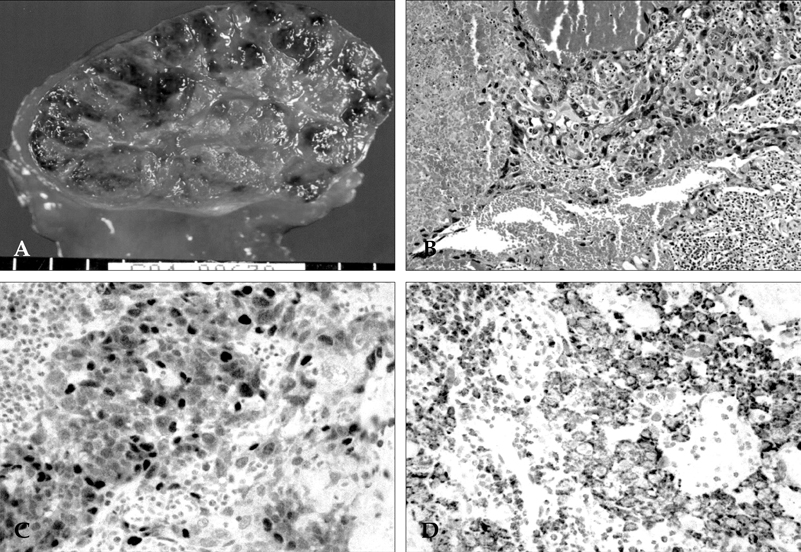Yonsei Med J.
2006 Dec;47(6):887-891. 10.3349/ymj.2006.47.6.887.
Pure Choriocarcinoma of Testis with Tumor-Infiltrating Lymphocytes and Granulomas
- Affiliations
-
- 1Department of Pathology, Dankook University College of Medicine, Cheonan, Korea. jaihyang@yahoo.co.kr
- KMID: 1777182
- DOI: http://doi.org/10.3349/ymj.2006.47.6.887
Abstract
- Pure choriocarcinoma is very rare in the testes, and host immune responses including tumor infiltrating lymphocytes are unusual in choriocarcinoma. This study reports a case of pure testicular choriocarcinoma with extensive lymphocytic infiltrate and granulomatous inflammation. Scrotal ultrasonography revealed a heterogeneous, hyperechoic intratesticular mass. -human chorionic gonadotropin levels were elevated in a radioimmunoassay. The hemorrhagic and necrotic solid mass was composed of two cell populations - mononuclear pleomorphic cells and intimately admixed multinucleated smudged cells. The tumor cells were positive for cytokeratin 7, epidermal growth factor receptors, human placental lactogen and p57. Many inflammatory cells were present within the tumor. The majority of infiltrating cells were CD8-positive cytotoxic cells, which also expressed granzyme-B and TIA-1. The tumor cells were positive for FasL, but negative for Fas. Therefore, this case seemed to escape the host defense response to the tumor due to the loss of Fas, although the cellular host immune response was still active.
MeSH Terms
Figure
Reference
-
1. Eble JN, Sauter G, Epstein JI, Sesterhenn IA. Eble JN, Sauter G, Epstein JI, Sesterhenn IA, editors. Tumours of the testis and paratesticular tissue. Tumours of the urinary system and male genital organs. 2004. Lyon: IARC Press;240–242.2. Parker C, Milosevic M, Panzarella T, Banerjee D, Jewett M, Catton C, et al. The prognostic significance of the tumour infiltrating lymphocyte count in stage I testicular seminoma managed by surveillance. Eur J Cancer. 2002. 38:2014–2019.3. Yakirevich E, Lefel O, Sova Y, Stein A, Cohen O, Izhak OB, et al. Activated status of tumour-infiltrating lymphocytes and apoptosis in testicular seminoma. J Pathol. 2002. 196:67–75.4. Torres A, Casanova JF, Nistal M, Regadera J. Quantification of immunocompetent cells in testicular germ cell tumours. Histopathology. 1997. 30:23–30.5. Nakanoma T, Nakamura K, Deguchi N, Fujimoto J, Tazaki H, Hata J. Immunohistological analysis of tumour infiltrating lymphocytes in seminoma using monoclonal antibodies. Virchows Arch A Pathol Anat Histopathol. 1992. 421:409–413.6. Rajashekhar G, Loganath A, Roy AC, Mongelli JM. Co-expression of Fas (APO-1, CD95)/Fas ligand by BeWo and NJG choriocarcinoma cell lines. Gynecol Oncol. 2003. 91:101–111.7. Knoeller S, Lim E, Aleta L, Hertwig K, Dudenhausen JW, Arck PC. Distribution of immunocompetent cells in decidua of controlled and uncontrolled (choriocarcinoma/hydatidiform mole) trophoblast invasion. Am J Reprod Immunol. 2003. 50:41–47.8. Ellis SA, Palmer MS, McMichael AJ. Human trophoblast and the choriocarcinoma cell line BeWo express a truncated HLA Class I molecule. J Immunol. 1990. 144:731–735.9. Yamada H, Polgar K, Hill JA. Cell-mediated immunity to trophoblast antigens in women with recurrent spontaneous abortion. Am J Obstet Gynecol. 1994. 170:1339–1344.10. Kilic M, Flossmann E, Flossmann O, Vogelsang H, Junker U, Chaouat G, et al. Jeg-3 human choriocarcinoma-induced immunosuppression: downregulation of interleukin-2, interleukin-2 receptor alpha-chain, and its Jak/Stat signaling pathway. Am J Reprod Immunol. 1999. 41:61–69.11. Markert UR, Kilic M, Schleussner E, Vogelsang H. Choriocarcinoma-induced suppression of lymphocyte activity. J Investig Allergol Clin Immunol. 2000. 10:323–326.12. Rajashekhar G, Loganath A, Roy AC, Mongelli JM. Resistance to Fas-mediated cell death in BeWo and NJG choriocarcinoma cell lines: implications in immune privilege. Gynecol Oncol. 2003. 91:89–100.



